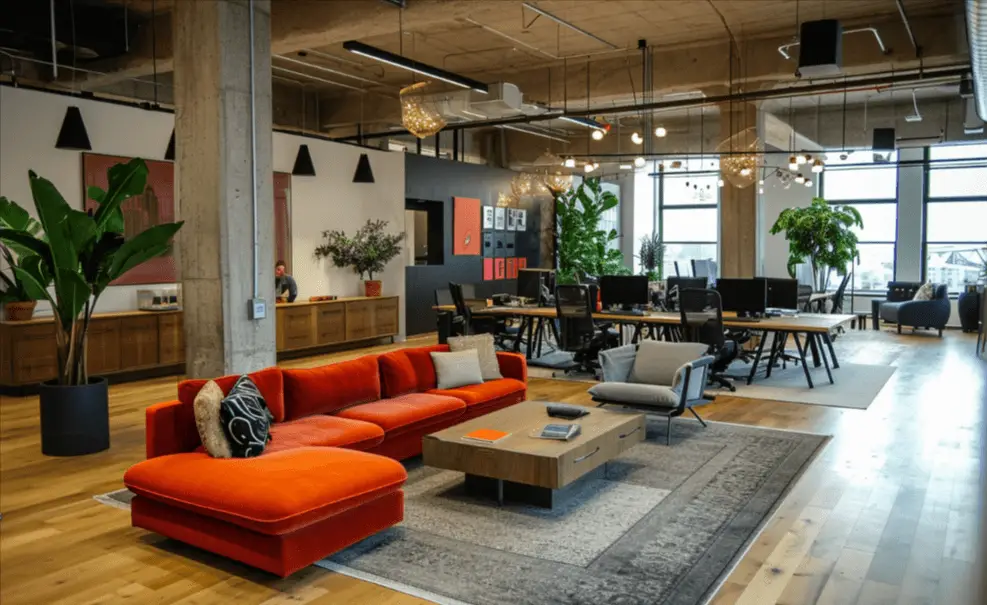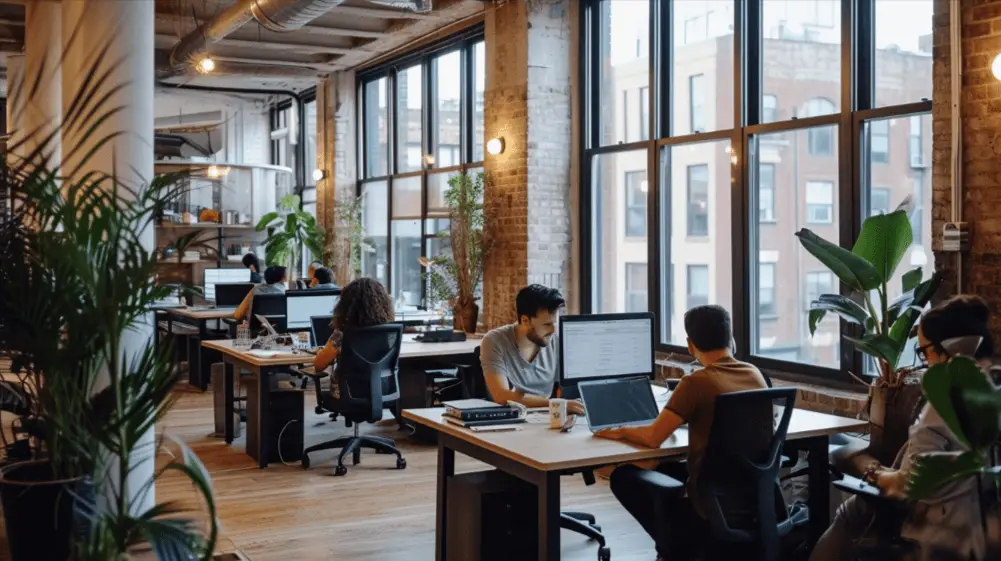The hot desking concept has transcended traditional office boundaries and offers a dynamic approach to workspace utilization. As the global workforce becomes more mobile and flexible, the intricacies of hot desking may look more and more appealing to hybrid and remote workers. But first, let’s discuss the basics of what hot desking actually is…
What is Hot Desking?
Hot desking is a workspace utilization strategy where workers can choose where they sit when they come into the office, as there’s no assigned desk for any one person. It can lead to a much more efficient use of the given space, especially among a hybrid workforce.
It’s important to note that there are typically two settings that the term “hot desking” applies to: the traditional office and a coworking space. Hot desking is just another phrase for “open seating” in your average coworking space. As a term, it typically has a good reputation, unlike its traditional office counterpart. In the traditional office setting, hot desking is more often used in a negative light, as it can easily resemble a laissez-faire attitude towards employees, giving an impression of not caring.
Even though the concept of hot desking has been popularized via coworking spaces, it has now been adopted in various forms in traditional offices. Unlike ‘hoteling,’ which involves reserving a specific desk or space ahead of time, hot desking is more spontaneous, offering flexibility and variety. Hoteling, often seen as a precursor to hot desking, provides a more structured approach, allowing workers to book their workspace in advance, thus ensuring availability and some degree of predictability. In contrast, hot desking is dynamic, aligning with the fluid nature of modern work practices.
Transitioning from a fixed desk to a hot desk has its benefits. Previously, I sat beside the same people each day and had a routine built around my desk. Now, since switching to a hotdesk, I’m meeting more people. The funny thing about hotdesks is that most people in the office usually head toward the same seat and feel a bit disappointed if their usual spot isn’t available. It seems we are creatures of habit, even when given the flexibility.

Danielle Thompson
Founder – Design Match
The ascent of hot desking aligns with the broader shift towards remote and hybrid work models. This trend is fueled not just by evolving technology but also by a growing recognition of the need for work flexibility and autonomy. The graph below is a perfect representation of this. Even before COVID forced much of the world into home offices, hot desking was already seeing an uptick in popularity and understanding because coworking (as a concept) became popular. In fact, hot desking is an entire membership category in coworking spaces that we see now.

For fully remote workers, hot desking offers a reprieve from the isolation of home offices, providing a stimulating environment that can boost creativity and productivity.
In hybrid models, it accommodates fluctuating office attendance, ensuring efficient use of space while supporting a diverse range of working styles. The rise of hot desking reflects a deeper change in work culture, where dynamic and adaptable environments are valued over traditional, static office setups.
Advantages of Hot Desking
Hot desking, when implemented with community and growth in mind, can yield significant benefits for remote and hybrid workers:
- Flexibility and Space Efficiency: It allows individuals to choose where they work based on their daily needs, promoting a sense of autonomy and personalization in the work experience.
- Cost-Effectiveness: For businesses, hot desking reduces the need for a fixed number of desks, cutting down on real estate and operational costs.
- Collaboration and Networking: It encourages spontaneous interactions and networking opportunities, vital for remote workers who might otherwise miss out on these collaborative moments (be sure to check out my post about team-building questions for remote workers!).
- Adaptability: Hot desking supports a dynamic work environment, crucial for businesses and workers who need to rapidly adapt to changing circumstances.
- Environmental Benefits: By optimizing space usage and resources, hot desking can contribute to a company’s sustainability goals.
- Inspiring Creativity: The change of scenery and interaction with different colleagues can spark new ideas and creative approaches to work.
- Enhanced Cross-Disciplinary Learning: Hot desking in a diverse environment allows remote workers to gain unexpected insights from professionals in completely different fields, fostering a culture of cross-disciplinary learning and innovation.
- Serendipitous Problem-Solving: The random nature of seating arrangements can lead to unplanned interactions where casual conversations turn into brainstorming sessions, solving problems in ways that structured meetings might not.
- Mood Matching Workspaces: Hot desking enables workers to choose their desk based on their mood or the specific task at hand. For instance, choosing a quiet corner for deep focus work or a lively area for tasks requiring high energy and creativity.
- Dynamic Work Identity: Regularly changing workspaces can encourage remote workers to adopt a more fluid and dynamic work identity. This adaptability can enhance their ability to handle diverse tasks and situations, a valuable skill in the ever-changing work landscape.
- ‘Workspace Tourism’ for Inspiration: For those in creative fields, hot desking can be akin to ‘workspace tourism.’ The opportunity to work from different desks, environments, or even coworking spaces in various cities can provide fresh perspectives and inspiration, much like travel does.
In the coworking space vs traditional office conversation, these advantages can manifest differently. Coworking spaces naturally lend themselves to networking and collaboration, often designed with hot desking in mind. In contrast, traditional offices may require more strategic planning to foster these interactions and ensure that hot desking does not disrupt established workflows.

Disadvantages of Hot Desking
Hot desking offers several benefits, but like anything, there are also some downsides to it as well. The disadvantages below will affect everyone differently based on your own working habits.
- Lack of Personal Space: The absence of a permanent workspace can lead to a feeling of impermanence and lack of personalization, which might affect employee morale and sense of belonging. For some people (like me), this is actually a strength. I like being put into situations that force me to mingle with others, especially in a shared workspace.
- Hygiene and Maintenance Issues: Shared workspaces raise concerns about cleanliness and the spread of germs, especially important in post-pandemic work environments.
- Potential for Disruption and Distraction: Frequent changes in seating can lead to disruptions, with workers needing time to adjust to new spaces, potentially impacting concentration and productivity.
- Impact on Employee Morale and Job Satisfaction: The uncertainty of not having a designated desk can lead to feelings of insecurity and dissatisfaction for some employees.
- Difficulty in Establishing Company Culture: The fluid nature of hot desking can make it challenging to establish and maintain a strong, cohesive company culture. However, this can be turned into an advantage if the office layout makes an effort to avoid isolated workspaces.
- Unpredictability in Work Environment: The lack of control over one’s work environment can be stressful, especially for those who prefer a consistent and predictable workspace.
- Reduced Accessibility for Some Employees: For employees with specific physical needs or disabilities, hot desking can pose accessibility challenges, as not all desks or areas may be equally accommodating.
- Risk of Overcrowding: In peak times, hot desking can lead to overcrowding, making it difficult to find a suitable workspace and potentially leading to a counterproductive environment.
These disadvantages are real, so real that many people will let them get in the way of having a productive workday. For this reason, it’s incredibly important to arrange the shared workspace in a way that is conducive to everyone’s needs from the beginning. You can’t please everybody, obviously, but many of these ‘disadvantages’ can be mitigated with some careful thought.
Where Do You Stand?
Hot desking, like any significant change, brings with it a spectrum of experiences – some invigorating, others challenging. It demands us to have discipline in our new freedom. For remote workers, it represents both a liberation from the confines of the traditional office and a journey into an uncharted communal workspace.
As we move forward, let us do so with the understanding that our workspaces are more than just physical locations – they are the breeding grounds for ideas, collaboration, and growth. In shaping these spaces, we are not just configuring desks and chairs; we are cultivating environments that hold the potential to elevate our collective potential.
Jared has worked remotely for 15 years in various marketing capacities, and has managed hundreds of marketing campaigns along the way. He has held freelance, agency, and in-house positions for companies large and small.


